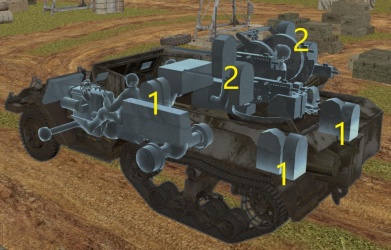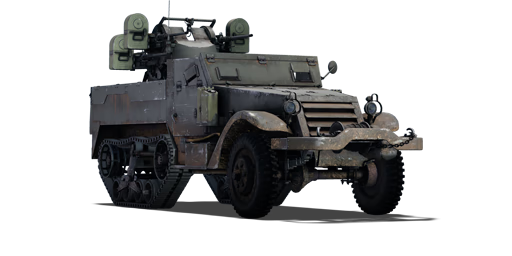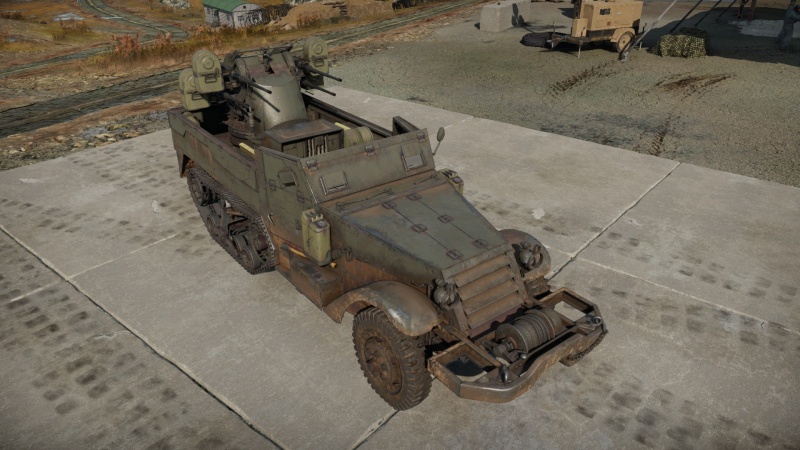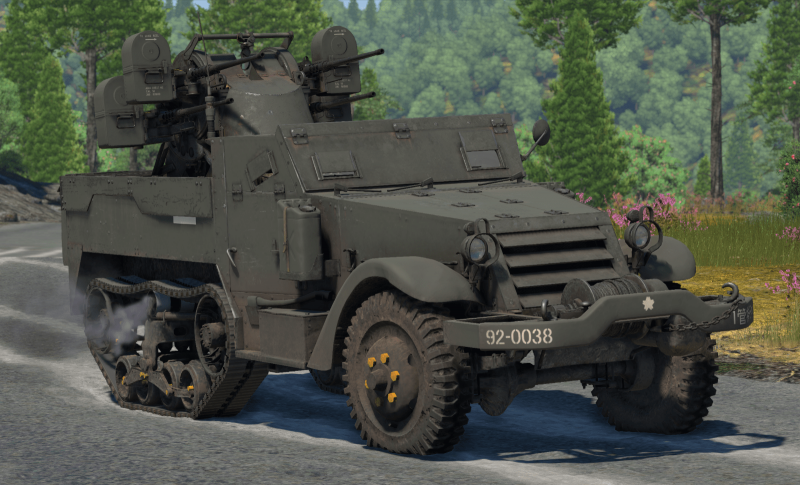M16 MGMC (Japan)
| This page is about the SPAA M16 MGMC (Japan). For other half-track vehicles based on the M3, see M3 Half-Track (Family). |
Contents
Description
The Multiple Gun Motor Carriage M16 is a rank II SPAA with a battle rating of 2.7 (AB/RB/SB) introduced in Update "Direct Hit". Although it was originally an American vehicle, around 170 M16s were supplied to the Japanese National Safety Force, and the JGSDF (Japan Ground Self Defense Forces) in 1954. Used in anti-aircraft and anti-personnel roles, it served alongside the American-supplied M15A1 CGMCs, M19A1s, and M42 Dusters until it was officially phased out of Japanese service in 1974.
The M16 MGMC is equipped with four .50 caliber machine guns mounted on a Maxson M45 Quadmount designed to knock enemy aircraft out of the sky.
The point of the M16 MGMC is to protect the team against enemy aircraft. Compared to other, autocannon-armed AA, the M16 MGMC puts up a hail of bullets that focuses on volume-of-fire rather than damage-per-round. This is not to discount the damage that .50 caliber rounds can do, however, as they have enough penetration to go through some armor and armored glass (features that most aircraft at the BR won't have much of), and easily set fuel tanks alight with incendiary rounds.
Multiple .50 caliber heavy machine guns allow for surprisingly decent self-defense against poorly armored enemy vehicles like armored cars, light tanks, and even some early medium tanks.
General info
Survivability and armour
Armour type:
- Rolled homogeneous armour
| Armour | Front (Slope angle) | Sides | Rear | Roof |
|---|---|---|---|---|
| Hull | 6.35 mm (31°) Hood front 12.7 mm (31°) Driver port |
6.35 mm | 6.35 mm | N/A |
| Turret | 12.7 mm | N/A | N/A | N/A |
Notes:
- Suspension bogies are 10 mm thick, suspension wheels are 15 mm thick, and tracks are 7 mm thick. Front wheels provide 2 mm armour.
Mobility
| Game Mode | Max Speed (km/h) | Weight (tons) | Engine power (horsepower) | Power-to-weight ratio (hp/ton) | |||
|---|---|---|---|---|---|---|---|
| Forward | Reverse | Stock | Upgraded | Stock | Upgraded | ||
| Arcade | 83 | 19 | 8.6 | 210 | 282 | 24.42 | 32.79 |
| Realistic | 76 | 18 | 131 | 148 | 15.23 | 17.21 | |
As a half-track, the M16 MGMC is light and thus agile. While it has a high top speed, the acceleration is quite slow: expect a cruise speed between 40 and 45 km/h. The reverse speed is good, allowing you to pull out of dangerous situations. Like all WW2 wheeled vehicles, you cannot turn on the spot and always need space to change direction. However, thanks to the rear tracks, your turn radius can be tight at slow speeds. Just remember that the faster you drive, the bigger the turn radius will be.
Changing directions in a cramped street can be difficult with the M16 MGMC. The lack of neutral steering makes turning on the spot slower than other vehicles (4 km/h): make sure to build a little speed before turning and you'll turn faster (12 km/h). The off-road mobility is average: it can reach around 14 km/h when fording and 18 km/h when driving uphill. The M16 MGMC has a very high cruise speed on hard surfaces (solid ground, roads). While its high speed is an advantage, it can turn into a disadvantage when maneuvering at high speed: the M16 MGMC starts oversteering when you turn because of its high center of gravity and ends up skidding uncontrollably. Be aware of this before gunning towards the frontline: limit your maximum speed and anticipate the braking phases. As it is equipped with front tires, the M16 MGMC struggles on soft terrain (sand, mud, snow). Light obstacles (fences and bushes) will make you bleed speed and medium to large obstacles (posts, trees, concrete blocks and parked vehicles) will stop your vehicle: avoid them.
Modifications and economy
Armaments
Main armament
| 12.7 mm M2HB (x4) | Turret rotation speed (°/s) | Reloading rate (seconds) | ||||||||||||
|---|---|---|---|---|---|---|---|---|---|---|---|---|---|---|
| Mode | Capacity (Belt) | Fire rate | Vertical | Horizontal | Stabilizer | Stock | Upgraded | Full | Expert | Aced | Stock | Full | Expert | Aced |
| Arcade | 4,800 (200) | 576 | -10°/+90° | ±180° | N/A | 52.8 | 73.1 | 88.8 | 98.2 | 104.5 | 18.20 | 16.10 | 14.84 | 14.00 |
| Realistic | 35.7 | 42.0 | 51.0 | 56.4 | 60.0 | |||||||||
Ammunition
- Common: API-T · I · AP · API-T
- API: API-T · AP-I · API-T
- AP: AP · AP · API-T
- APIT: API-T
| Penetration statistics | ||||||
|---|---|---|---|---|---|---|
| Belt | Penetration @ 0° Angle of Attack (mm) | |||||
| 10 m | 100 m | 500 m | 1,000 m | 1,500 m | 2,000 m | |
| Common | 31 | 30 | 26 | 22 | 18 | 15 |
| API | 30 | 29 | 24 | 20 | 16 | 13 |
| AP | 31 | 30 | 26 | 22 | 18 | 15 |
| APIT | 30 | 29 | 24 | 20 | 16 | 13 |
| Belt details | |||||||||
|---|---|---|---|---|---|---|---|---|---|
| Belt | Type of warhead |
Velocity (m/s) |
Projectile Mass (kg) |
Fuse delay (m) |
Fuse sensitivity (mm) |
Explosive Mass (TNT equivalent) (g) |
Ricochet | ||
| 0% | 50% | 100% | |||||||
| APIT | API-T | 929 | 0.04 | N/A | N/A | N/A | 47° | 56° | 65° |
Ammo racks

| Full ammo |
1st rack empty |
2nd rack empty |
Visual discrepancy |
|---|---|---|---|
| 24 | 12 (+12) | 0 (+24) | Yes |
Notes:
- Although there are 24 ammo boxes, only 10 are modeled including 4 loaded on the machine guns.
- Since there are four .50 M2HB machine guns, each reload will load 4 ammo boxes onto the guns with each box containing 200 rounds.
Usage in battles
It is recommended to find a good open spot, most times it is enough to stay in the spawn point. The ammunition options for this vehicle are API (Armor-Piercing, Incendiary), APIT (Armor-Piercing, Incendiary, Tracer), and AP (Armor-Piercing). The AP belt consists of majority AP rounds for punching through armor. The API belt has AP rounds followed by Incendiary rounds, which have a higher chance of lighting the target on fire. The APIT belt has AP rounds followed by Incendiary rounds, followed by Tracer rounds, which can set targets on fire and are very visible, which helps with aiming. Keep note that any of these belts are going to be like bright lasers in the sky when firing. The tracers will alert anyone who sees it to your position, so try to be careful where and when you are firing. If you stop to shoot at a target, it is advised to move positions or hide so that the enemy doesn't know exactly where you are.
Tracers can be used to easily mark enemy snipers, as their brightness and noise will alert friendlies to look at where they are going.
"The Meat Chopper" is inaccurate when enemy planes are operating at high altitudes, but in these cases, its function is more psychological than effective. Shooting short bursts at enemy planes at high altitudes will show them that the team is covered by vigilant AA fire and that it will be difficult to attack directly.
When an enemy is diving, the best way to defend is by creating a thick fire curtain with prolonged bursts. One of the most vulnerable moments for aircraft is when they have just dropped bombs or rockets and start to climb. Aircraft in that position are flying very slow and become easy targets. Another really vulnerable moment for an aircraft is when it has pulled up to either pull away from the ground or to follow a plane and is stalling. If an aircraft does that, it is essentially hovering still in the air. Fire a quick burst only slightly ahead to account for bullet drop and a little bit below to anticipate the plane falling back towards the ground.
Take care if planes are attacking. Fighters with their quick-firing machine guns and cannons are a menace to the M16 MGMC. When you notice rounds starting to land around you, start moving while firing back and take cover behind trees or buildings.
Watch your remaining ammunition closely. The M16 MGMC has 800 rounds to fire but reloading is very slow. When reloading, the M16 MGMC is defenseless and can make the whole team vulnerable in the worst moments. When low on ammo, try to dump the rest of the rounds to reload before the aircraft comes back.
The M16 MGMC is equipped with M2HB .50 cal heavy machine guns which can do damage to lightly armored targets, but will not pen more than 26mm of armor, so it is ill-advised to attack anything heavier than a moderately armed light tank with intent to destroy.
Artillery barrages are very dangerous, move immediately and relocate when you see the warning message.
Pros and cons
Pros:
- Powerful guns can shred planes with well-aimed bursts within 1 km
- AP/API shells are powerful enough to damage and destroy enemy light tanks and other SPAAs
- Fast on flat ground and go faster through certain terrain that would impede fully-wheeled vehicles
- Higher fire rate than autocannon SPAA at the BR
- Great acceleration
- Fast turret traverse allows for tracking aircraft easily
- Armor can shrug off rifle caliber ammunition <7.92 mm
- Fast reverse speed, can evacuate an area quickly if necessary
- Stable turret and accurate on the move
Cons:
- Armour will not resist HMG fire >7.92mm and shrapnel
- Nearby explosions will seriously damage the vehicle and injure the crew
- Fighter aircraft, especially cannon armed fighters, can quickly destroy this vehicle due to tight crew placement
- Cannot consistently destroy enemy armored vehicles
- Light weight makes towing or shoving heavier allies or destroyed vehicles nearly impossible
- Prone to tipping over when turning at high speeds or travelling across steep inclines
- Only 1 spare crew member
- No neutral steering
- Open top armor allows for shrapnel and machine gun fire to hit crew
- Vulnerable to artillery barrages
- Tracer rounds bring a lot of attention and can draw friendly fire in Simulator mode
History
Development
The role of a mobile anti-aircraft vehicle in the US Army was seen as necessary in order to protect ground troops from enemy aircraft at any place of their deployment. The first such development was the M13 MGMC, which was an anti-aircraft system of two .50 cal machine gun on the back of an M3 Half-Track car. The M13 served with some success, but by 1943 an upgraded version was in production.
The new vehicle in development was an improvement over the M13 MGMC from replacing the two .50 cal machine guns with four instead, while still based off the M13 design by using the M3 Half-Track as the chassis. The prototype was called the T61 MGMC, but once accepted at the Aberdeen Proving Grounds, it was designated the M16 Multiple Gun Motor Carriage. During the evaluations, some changes to the design were made, including the addition of a gun shield. Production started in May 1943 and continued on until March 1944 with the production of 2,877 M16 MGMC vehicles by White Motor Company. An additional 568 M13 and 109 T10 Half-tracks were also converted into M16 vehicles for a total of about 3,550 M16 units made.
Combat in American service
The M16 MGMC saw service in early 1944, replacing the M13 that came before it. Deployment of the M16 MGMC is usually alongside the M15 CGMC, another anti-aircraft weapon equipped with a 37 mm autocannon as well as two .50 machine guns. The M16 MGMC was very popular with the troops as not only was it able to take down low-flying aircraft with relative ease, it was also used in an infantry support role where it earns the nickname "The Meat Chopper". The ability to provide covering fire with its four .50 calibre machine guns give the M16 a huge firepower advantage over the standard infantry and in some cases, were used to cut down trees where snipers were suspected to be hiding. The M16 also saw service with the Allies in the British Commonwealth and the Soviet Union, where they make use of it in the same way America did in anti-aircraft and ground support roles. The M16 saw service in the Italian Campaign, the French Campaign, and the Battle of the Bulge.
After World War II, the M16 MGMC still saw service in American forces in the Korean War, as well as by their South Korean allies. While still superb at a ground support role, the advancing technology in aircraft make them more advanced and durable to the .50 calibre machine guns and so its effect as an anti-aircraft gun has diminished. By late 1951, the M16 MGMC was declared a "limited standard" and were gradually retired from US service, though they continued to serve until the end of the US involvement in the Korean War. The M16 MGMC was finally declared obsolete by the US Army in 1958.
M16 MGMCs in Japanese service
Prior to the establishment of the Japanese Ground Self-Defense Force in July of 1954, the Japanese were delegated with a security force called the "National Safety Force" (1952-1954). Similar in function to a national police, they were trained by American officers and equipped with American military equipment. Limited under treaty from building their own military designs, Japan sought assistance from the US to provide its heavy equipment. In particular, Japanese personnel were supplied with 168 M3/M16 half-tracks for logistical needs but also close infantry support. M45 turrets with quad .50 cal mountings were supplied from surplus American stocks and fitted to the vehicles. Under the 1st District Force (NSF) the first anti-air units were comprised using the "hand-me down" M16s. These vehicles would pass into the JGSDF, serving alongside other American-supplied SPAAs like the M15A1 CGMC, M19A1, and M42 Duster until they were officially phased out of Japanese service in 1974 after being deemed obsolete for their primary purpose.
In-game description
The W.L. Maxson Corporation developed the M45 turret emplacement, which was equipped with four 12.7 mm Browning M2HB machine guns, to meet troop requirements for more concentrated defensive fire. The new turret was tested on the M2 half-track personnel carrier chassis, later moving to the M3 chassis.
The self-propelled AA weapon with the new turret went through trials and was accepted as the M16 MGMC.
The new vehicles were produced by the White Motor Company beginning in May 1943, continuing through 1943 and into 1944. In all, 2,877 units were assembled.
Almost all of the M16 MGMCs served in the US army's AA divisions, while an additional 70 were sent to the Free French army. The model was used primarily in the European theater to go along with a small number that saw action in the Philippines.
The M16 MGMC was successfully used against both air and ground targets, as well as to take out enemy infantry. It was also used somewhat widely by US army divisions during the Korean War, after which it was removed from service.
Media
Excellent additions to the article would be video guides, screenshots from the game, and photos.
See also
External links
Paste links to sources and external resources, such as:
- topic on the official game forum;
- other literature.
| Japan anti-aircraft vehicles | |
|---|---|
| Ke-Ni Derivatives | Ta-Se · So-Ki |
| Wheeled | Type 94 |
| Tracked | SUB-I-II |
| Radar SPAAG | Type 87 |
| Missile SPAA | Type 93 · Type 81 (C) |
| USA | ▅M16 MGMC · ▅M19A1 · ▅M42 |






